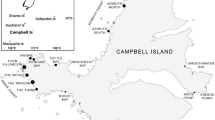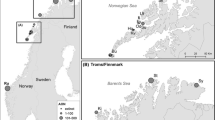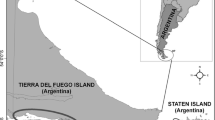Abstract
Penguins are important top consumers in marine food webs and are one of the most threatened bird families, especially by climate change and food web alterations by marine fisheries. Yet, long-term population trends are lacking or are uncertain for many populations. Seven species of penguins breeding at the French Southern Territories in the southern Indian Ocean on the Crozet, Kerguelen, Saint-Paul–Amsterdam archipelagos and in Terre Adélie/Adelie Land, Antarctica are monitored regularly. This monitoring started in the early 1950s and most populations have been surveyed during the past four years, allowing assessments of population trends. King penguins increased at nearly all breeding sites within the Crozet and Kerguelen archipelagos. Emperor penguins have decreased at Terre Adélie/Adelie Land, with a partial recovery of the colony during the 2010s. Gentoo penguin populations at Crozet and Kerguelen are highly variable but stable. Adélie penguins have been increasing in Terre Adélie/Adelie Land. The trends in eastern rockhopper penguins vary between colonies and archipelagos. Northern rockhopper penguins have continuously decreased in numbers at Amsterdam Island, but appear to have increased at the nearby Saint-Paul Island. Macaroni penguins have first increased and then stabilized since the 2000s at Kerguelen and are stable at the Crozet Islands. Overall, most penguin populations breeding in the French Southern Territories increased or were stable over the past 30–60 years, with the exception of the northern rockhopper penguin, king and gentoo penguins on Crozet and the emperor penguin. The ecological reasons for these trends are poorly understood and require further investigation.








Similar content being viewed by others
References
Agnew DJ (1997) The CCAMLR ecosystem monitoring programme. Antarct Sci 9:235–242
Ainley DG, Clarke ED, Arrigo K et al (1990s) Decadal-scale changes in the climate and biota of the Pacific sector of the Southern Ocean, 1950s to the 1990s. Antarct Sci 17:171–182
Ainley DG, Ribic CA, Ballard G et al (2004) Geographic structure of Adélie penguin populations: overlap in colony-specific foraging areas. Ecol Monogr 74:159–178
Aubert De La Rue E (1932) La pêche aux Iles Saint-Paul et Amsterdam. Revue des Travaux de l'Institut des Pêches Maritimes 5:53–109
Barbraud C, Delord K, Micol T, Jouventin P (1999) First census of breeding seabirds between Cap Bienvenue (Terre-Adélie) and Moyes Islands (King George V Land), Antarctica: new records for Antarctic seabird populations. Polar Biol 21:146–150
Barbraud C, Delord K, Weimerskirch H (2015) Extreme ecological response of a seabird community to unprecedented sea ice cover. Royal Soc Open Sci 2:140456
Barbraud C, Gavrilo M, Mizin Y, Weimerskirch H (2011) Comparison of emperor penguin declines between Pointe Géologie and Haswell Island over the past 50 years. Antarct Sci 23:461–468
Barbraud C, Weimerskirch H (2003) Climate and density shape population dynamics of a marine top predator. Proc Royal Soc Lond B 270:2111–2116
Barbraud C, Weimerskirch H (2001) Emperor penguins and climate change. Nature 411:183–186
Bauer A (1967) Dénombrement des manchotières de l’archipel des Crozet et des îles Kerguelen à l’aide de photographies aériennes verticales. Terres Australes et Antarctiques Françaises 41:3–21
Baylis A, Wolfaardt A, Crofts S et al (2013) Increasing trend in the number of southern rockhopper penguins (Eudyptes c. chrysocome) breeding at the Falkland Islands. Polar Biol 36:1007–1018
Baylis AM, Zuur AF, Brickle P, Pistorius PA (2012) Climate as a driver of population variability in breeding gentoo penguins Pygoscelis papua at the Falkland Islands. Ibis 154:30–41
Boersma PD (2008) Penguins as marine sentinels. Bioscience 58:597–607
Boersma PD, Borboroglu PG, Gownaris NJ, Bost CA, Chiarada A, Ellis S, Schneider T, Seddon P, Simeone A, Trathan AN, Waller LJ, Wienecke B (2019) Applying science to pressing conservation needs for penguins. Conserv Biol. https://doi.org/10.1111/cobi.13378
Bost CA, Jouventin P (1990) Evolutionary ecology of the gentoo penguin Pygoscelis papua. In: Davis L, Darby J (eds) Penguin biology. Academic Press, New York, pp 85–112
Bost CA, Cotté C, Terray P et al (2015) Large-scale climatic anomalies affect marine predator foraging behaviour and demography. Nat Commun 6:8220
Bourret V, Gamble A, Tornos J, Jaeger A, Delord K, Barbraud C, Tortosa P, Kada S, Thiebot JB, Thibault E, Gantelet H, Weimerskirch H, Garnier R, Boulinier T (2018) Vaccination protects endangered albatross chicks against avian cholera. Conserv Lett 11:e12443
Brooke M (2004) Albatrosses and petrels across the world. Oxford University Press, Oxford
Caughley G (1977) Analysis of vertebrate populations. Wiley, London
Clark JS, Bjørnstad ON (2004) Population time series: process variability, observation errors, missing values, lags, and hidden states. Ecology 85:3140–3150
Clausen AP, Huin N (2003) Status and numerical trends of king, gentoo, and rockhopper penguins breeding in the Falkland Islands. Waterbirds 26:389–403
Constable AJ, Melbourne-Thomas J, Corney SP et al (2014) Climate change and Southern Ocean ecosystems I: how changes in physical habitats directly affect marine biota. Glob Change Biol 20:3004–3025
Cooper J, Crawford RJM, De Villiers MS, Dyer BM, Hofmeyr GJG, Jonker A (2009) Disease outbreaks among penguins at sub-Antarctic Marion Island. Mar Ornithol 37:193–196
Crawford R (1998) Responses of African penguins to regime changes of sardine and anchovy in the Benguela system. Afr J Mar Sci 19:355–364
Crawford RJ, Whittington P, Upfold L et al (2009) Recent trends in numbers of four species of penguins at the Prince Edward Islands. Afr J Mar Sci 31:419–426
Croxall J, Lishman G (1987) The food and feeding ecology of penguins. In: Croxall JP (ed) Seabirds: feeding ecology and role in marine ecosystems. Cambridge University Press, Cambridge, pp 101–133
Croxall JP, Butchart SHM, Lascelles B et al (2012) Seabird conservation status, threats and priority actions: a global assessment. Bird Conserv Int 22:1–34
Cuthbert R, Cooper J, Burle MH, Glass CJ (2009) Population trends and conservation status of the Northern Rockhopper Penguin Eudyptes moseleyi at Tristan da Cunha and Gough Island. Bird Conserv Int 19:109–120
Delord K, Barbraud C, Weimerskirch H (2004) Long-term trends in the population size of king penguins at Crozet archipelago: environmental variability and density dependence? Polar Biol 27:793–800
Delord K, Roudaut G, Guinet C et al (2015) Kite aerial photography: a low-cost method for monitoring seabird colonies. J Field Ornithol 86:173–179
Despin B, Mougin J, Segonzac M (1972) Oiseaux et mammifères de l’ile de l’Est. CNFRA 31:1–106
Foley CM, Hart T, Lynch HJ (2018) King penguin populations increase on South Georgia but explanations remain elusive. Polar Biol 41:1111–1122
Forcada J, Trathan P, Reid K et al (2006) Contrasting population changes in sympatric penguin species in association with climate warming. Glob Change Biol 12:411–423
Forcada J, Trathan PN (2009) Penguin responses to climate change in the Southern Ocean. Glob Change Biol 15:1618–1630
Frugone MJ, Lowther A, Noll D, Ramos B, Pistorius P, Dantas GPM, Petry MV, Bonadonna F, Steinfurth A, Polanowski A, Raya Rey A, Lois NA, Pütz K, Trathan P, Wienecke B, Poulin E, Vianna JA (2018) Contrasting phylogeographic pattern among Eudyptes penguins around the Southern Ocean. Sci Rep 8:17481. https://doi.org/10.1038/s41598-018-35975-3
Fraser W, Trivelpiece W, Ainley D, Trivelpiece S (1992) Increase in Antarctic penguin populations: reduced competition with whales or a loss of sea ice due to environmental warming? Polar Biol 11:525–531
Gamble A, Garnier R, Jaeger A, Gantelet H, Thibault E, Tortosa P, Bourret V, Thiebot JB, Delord K, Weimerskirch H, Tornos J, Barbraud C, Boulinier T (2019) Exposure of breeding albatrosses to the agent of avian cholera: dynamics of antibody levels and ecological implications. Oecologia 189:939–949
Garcia-Borboroglu PG, Boersma PD (2015) Penguins: natural history and conservation. University of Washington Press, Seattle
Guinard E, Weimerskirch H, Jouventin P (1998) Population changes and demography of the Northern Rockhopper Penguin on Amsterdam and Saint Paul islands. Colon Waterbirds 21:222–228
Guinet C, Cherel Y, Ridoux V, Jouventin P (1996) Consumption of marine resources by seabirds and seals in Crozet and Kerguelen waters: changes in relation to consumer biomass 1962–65. Antarct Sci 8:23–30
Guinet C, Jouventin P, Malacamp J (1995) Satellite remote sensing in monitoring change of seabirds: use of spot image in king penguin population increase at Ile aus Cochons, Crozet Archipelago. Polar Biol 15:511–515
Heupink TH, van den Hoff J, Lambert DM (2012) King penguin population on Macquarie Island recovers ancient DNA diversity after heavy exploitation in historic times. Biol Lett 8:586–589
Hiscock JA, Chilvers BL (2014) Declining eastern rockhopper (Eudyptes filholi) and erect-crested (E. sclateri) penguins on the Antipodes Islands New Zealand. N Z J Ecol 38:124–134
Horswill C, Ratcliffe N, Green JA, Phillips RA, Trathan PN, Matthiopoulos J (2016) Unravelling the relative roles of top-down and bottom-up forces driving population change in an oceanic predator. Ecology 97:1919–1928
Iles D, Lynch H, Ji R, Barbraud C, Delord K, Jenouvrier S (2020) Sea ice predicts long-term trends in Adélie penguin population growth, but not annual fluctuations: results from a range-wide multi-scale analysis. Glob Change Biol. https://doi.org/10.1111/gcb.15085
IUCN (2019) The IUCN Red List of Threatened Species. Version 2019–1. https://www.iucnredlist.org
Jaeger A, Lebarbenchon C, Bourret V et al (2018) Avian cholera outbreaks threaten seabird species on Amsterdam Island. PLoS ONE 13:e0197291. https://doi.org/10.1371/journal.pone.0197291
Jenouvrier S, Barbraud C, Weimerskirch H (2006) Sea ice affects the population dynamics of Adélie penguins in Terre Adélie. Polar Biol 29:413–423
Jenouvrier S, Barbraud C, Weimerskirch H, Caswell H (2009a) Limitation of population recovery: a stochastic approach to the case of the emperor penguin. Oikos 118:1292–1298
Jenouvrier S, Caswell H, Barbraud C et al (2009b) Demographic models and IPCC climate projections predict the decline of an emperor penguin population. Proc Natl Acad Sci USA 106:1844–1847
Kooyman GL, Ponganis PJ (2016) Rise and fall of Ross Sea emperor penguin colony populations: 2000 to 2012. Antarct Sci 29:201–208
Laws RM (1977) Seals and whales of the Southern Ocean. Phil Trans R Soc Lond B 279:81–96
Le Bohec C, Durant JM, Gauthier-Clerc M et al (2008) King penguin population threatened by Southern Ocean warming. Proc Natl Acad Sci USA 105:2493–2497
Lebreton J, Gimenez O (2013) Detecting and estimating density dependence in wildlife populations. J Wildl Manage 77:12–23
Lescroel A, Bost C-A (2006) Recent decrease in gentoo penguin population at Iles Kerguelen. Antarct Sci 18:171–174
Lynch HJ, Naveen R, Trathan PN, Fagan WF (2012) Spatially integrated assessment reveals widespread changes in penguin populations on the Antarctic Peninsula. Ecology 93:1367–1377
Micol T, Jouventin P (2002) Eradication of rats and rabbits from Saint-Paul Island, French Southern territories. In: Veitch CR, Clout MN (eds) Turning the tide: the eradication of invasive species. IUCN SSC Invasive Species Specialist Group, IUCN, Gland, pp 199–205
Niel C, Lebreton JD (2005) Using demographic invariants to detect overharvested bird populations from incomplete data. Conserv Biol 19:826–835
Olsson O, Van der Jeugd HP (2002) Survival in king penguins Aptenodytes patagonicus: temporal and sex-specific effects of environmental variability. Oecologia 132:509–516
Plummer M (2003) JAGS: a program for analysis of Bayesian graphical models using Gibbs sampling. Austria, Vienna
Robertson G, Wienecke B, Emmerson L, Fraser AD (2014) Long-term trends in the population size and breeding success of Emperor Penguins at the Taylor Glacier colony, Antarctica. Polar Biol 37:251–259
Ropert-Coudert Y, Chiaradia A, Ainley D et al (2019) Happy feet in a hostile world? The future of penguins depends on proactive management of current and expected threats. Front Mar Sci 6:248
Ropert-Coudert Y, Kato A, Meyer X et al (2015) A complete breeding failure in an Adélie penguin colony correlates with unusual and extreme environmental events. Ecography 38:111–113
Rounsevell DE, Copson GR (1982) Growth rate and recovery of a king penguin, Aptenodytes patagonicus, population after exploitation. Aust Wildl Res 9:519–525
Royama T (2012) Analytical population dynamics. Springer Science & Business Media, Berlin
Salton M, Kliska K, Carmichael N, Alderman R (2019) Population status of the endemic royal penguin (Eudyptes schlegeli) at Macquarie Island. Polar Biol 42:771–781
Scheffer A, Trathan PN, Edmonston JG, Bost CA (2016) Combined influence of meso-scale circulation and bathymetry on the foraging behaviour of a diving predator, the king penguin (Aptenodytes patagonicus). Progress Oceanogr 141:1–16
Southwell C, Emmerson L, McKinlay J et al (2015) Spatially extensive standardized surveys reveal widespread, multi-decadal increase in East Antarctic Adélie penguin populations. PLoS ONE 10:e0139877
Stenseth NC, Chan K-S, Tavecchia G et al (2004) Modelling non–additive and nonlinear signals from climatic noise in ecological time series: Soay sheep as an example. Proc R Soc Lond B 271:1985–1993
Trathan PN, Forcada J, Murphy EJ (2007) Environmental forcing and Southern Ocean marine predator populations: effects of climate change and variability. Phil Trans R Soc B 362:2351–2365
Trathan PN, Fretwell PT, Stonehouse B (2011) First recorded loss of an emperor penguin colony in the recent period of Antarctic regional warming: implications for other colonies. PLoS ONE 6:e14738
Trathan PN, García-Borboroglu P, Boersma D et al (2015) Pollution, habitat loss, fishing, and climate change as critical threats to penguins. Conserv Biol 29:31–41
Trivelpiece WZ, Hinke JT, Miller AK et al (2011) Variability in krill biomass links harvesting and climate warming to penguin population changes in Antarctica. Proc Natl Acad Sci USA 108:7625–7628
Weimerskirch H (2007) Are seabirds foraging for unpredictable resources? Deep Sea Res Part II Top Stud Oceanogr 54:211–223
Weimerskirch H, Le Bouard F, Ryan PG, Bost C (2018) Massive decline of the world’s largest king penguin colony at Ile aux Cochons, Crozet. Antarct Sci 30:236–242
Williams TD (ed) (1995) The penguins. Oxford University Press, Oxford
Woehler EJ, Croxall JP (1997) The status and trends of Antarctic and sub-Antarctic seabirds. Mar Ornithol 25:43–66
Acknowledgements
This study was funded by the French Polar Institute (project IPEV 109), Réserve Naturelle Nationale des Terres Australes Françaises, and the Zone Atelier Antarctique (LTSER France, CNRS-INEE). We thank all the fieldworkers involved in the long-term monitoring programs at Terre Adélie, Crozet, Kerguelen, Amsterdam and Saint-Paul archipelagos. We thank F. Stephen Dobson and two anonymous reviewers for helpful comments on the manuscript.
Author information
Authors and Affiliations
Corresponding author
Ethics declarations
Conflict of interest
All authors declare that they have no conflict of interest.
Ethical approval
The study took place in the National Reserve of “Terres Australes Françaises” and was approved by the Préfet des TAAF, the ethics committee of IPEV and the “Comité de l’Environnement Polaire”.
Additional information
Publisher's Note
Springer Nature remains neutral with regard to jurisdictional claims in published maps and institutional affiliations.
Electronic supplementary material
Below is the link to the electronic supplementary material.
Rights and permissions
About this article
Cite this article
Barbraud, C., Delord, K., Bost, C.A. et al. Population trends of penguins in the French Southern Territories. Polar Biol 43, 835–850 (2020). https://doi.org/10.1007/s00300-020-02691-6
Received:
Revised:
Accepted:
Published:
Issue Date:
DOI: https://doi.org/10.1007/s00300-020-02691-6




